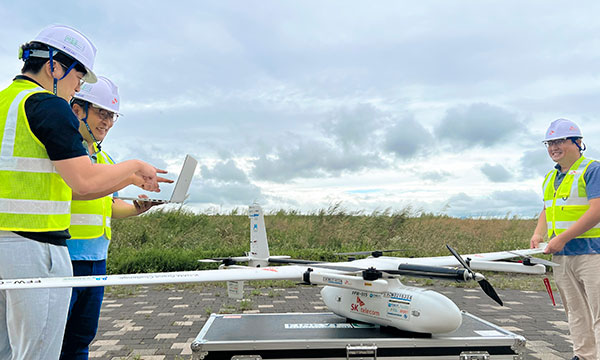상공망 품질 실시간 데이터 시각화
시뮬레이터, 통신 품질 방해 요소 분석
SKT가 상공망 기술 개발을 통해 UAM 시대를 준비한다.
SKT가 지난 31일 UAM용 상공망의 통신 품질 실·예측 및 분석을 위한 통합 솔루션과 시뮬레이터를 개발했다고 밝혔다.
이번에 개발한 솔루션은 300~600m의 운항 고도와 100~150km/h의 순항 속도로 도심·준도심·관광지역 상공 항로를 비행하는 UAM 기체와 유사한 통신 환경을 갖춘 드론을 활용해 상공망의 품질을 측정하는 기술이다.
드론을 통해 측정한 상공망 품질 데이터를 분석 툴을 활용해 실시간 표시하고, 측정 결과를 지도와 그래프, 도표로 시각화해 보여준다. 또한 UAM 탑승객이 스마트 디바이스를 사용하는 시나리오도 적용해 상공망의 통신 서비스 품질을 평가할 수 있게 됐다.
UAM용 상공망의 통신 품질 예측을 위한 시뮬레이터도 개발됐다. UAM용 상공망 통신 품질 분석 통합 솔루션과 유기적으로 통합 운영되며, 비행 경로 및 고도 설정, 안테나 높이, 상향 틸트, 지향 각도 및 빔 패턴 등 통신 품질에 변화를 주는 여러 요소들의 영향을 통합 분석할 수 있다. 기지국 설치 환경, 지상망 간섭 등 제약 상황을 고려한 상공망 투자비 산출 및 최적 설계 방안 도출에 활용 가능할 것으로 기대된다.
SKT는 향후 최적의 통신 장비 설정값을 추천하는 AI 기반 최적 설계 모델을 개발해 시뮬레이터 성능을 높여 상공망 품질을 높이고 분석 시간을 단축할 계획이다.
드론을 통해 측정한 상공망 품질 실측 데이터는 표준 전파 모델을 적용한 예측 시뮬레이터에 반영되어 예측 오차를 최소화하는데 사용되고, 시뮬레이터의 결과는 이후 실증 및 상용 상공망 통신 품질 성능 향상에 사용된다.
한편 SKT는 UAM용 상공망 통신의 품질 향상을 위한 다양한 기술 개발에 한창이다. 전용 안테나 및 상향 틸트, 빔패턴 최적화 기술, 기체 핸드오버 기술 등과 상공망 통신 장비 고도화를 하기 위해 다양한 제조사들과 전략적 협력 체계를 구축하고 있다. UAM 기체·운항 분야 글로벌 협력사 조비 에비에이션(Joby Aviation)이 대표적이다.
SKT는 지난 3월 MWC 2023에서 UAM을 위한 상공망 비전을 제시했고, 작년부터 고흥 및 양평에 구축한 시범 상공망 테스트베드에서 통신 품질 점검을 실시하고 있다. 또한 관련 6G 포럼 등에서 6G 글로벌 표준화 작업, 백서 출간 등을 통해 미래 네트워크 준비를 추진 중이다.
류정환 SKT 인프라 전략기술CT담당(부사장)은 “UAM 서비스를 위한 이동통신 기반 상공망 통신을 위해서는 주파수, 전송 기법, 장비 등 전분야에 걸친 기술 개발이 필요하다”며, “SKT는 향후 UAM이 고객들의 안정적 이동 수단이 될 수 있도록 5G 뿐만 아니라 향후 6G 진화 핵심 기술 개발에 최선을 다할 것”이라고 밝혔다.
